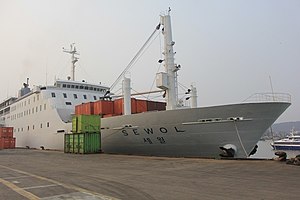MV Sewol

MV Sewol at Incheon in March 2014
|
|
| History | |
|---|---|
| Name: |
|
| Owner: |
|
| Port of registry: | |
| Builder: | Hayashikane Shipbuilding & Engineering Co. Ltd., Nagasaki, Japan |
| Yard number: | 1006 |
| Launched: | 13 April 1994 |
| Completed: | June 1994 |
| Identification: | IMO number: 9105205 |
| Fate: | Capsized and sank on 16 April 2014 |
| General characteristics | |
| Type: | RoPax ferry |
| Tonnage: | |
| Length: | 145.61 m (477 ft 9 in) |
| Beam: | 22.00 m (72 ft 2 in) |
| Draught: | 6.26 m (20 ft 6 in) |
| Depth: | 14.00 m (45 ft 11 in) |
| Installed power: |
|
| Propulsion: |
|
| Speed: | 21.5 knots (39.8 km/h; 24.7 mph) |
| Capacity: |
|
| Crew: | 35 |
MV Sewol (Korean: 세월호, Hanja: 世越號, Beyond the World) was a Korean vehicle-passenger ferry, built and previously operated in Japan. It was operated between Incheon to Jeju. On 16 April 2014 Sewol capsized and sank with the loss of 304 passengers and crew.
Sewol was a RoPax ferry that was built by the Japanese company Hayashikane Shipbuilding & Engineering Co. Ltd. (Japanese: 林兼船渠) in 1994. At 146 m (479 ft) in length and 22 m (72 ft) in width, she could carry 921 passengers, or a total of 956 persons, including the crew. She had a legal capacity for 180 vehicles and 154 regular cargo containers. The maximum speed of the ship was 22 knots (41 km/h; 25 mph).
The ferry was originally known as Ferry Naminoue (Japanese: フェリーなみのうえ) between 1994 and 2012, and had been operated in Japan for almost 18 years without any accidents. In 2012, the ship was later bought for ₩11.6 billion (US$11.3 million) by Chonghaejin Marine Company, controlled by the family of businessman Yoo Byung-eun. The ship was renamed Sewol, and refurbished. Modifications included adding extra passenger cabins on the third, fourth, and fifth decks, raising the passenger capacity by 117, and increasing the weight of the ship by 239 tons. After regulatory and safety checks by the Korean Register of Shipping, the ship began her operation in South Korea on 15 March 2013. The ship made three round-trips every week from Incheon to Jeju. In February 2014 it was reported that Sewol again passed a vessel safety inspection by the South Korean Coast Guard following an intermediate survey to ensure the ship remained in a general condition which satisfied requirements set by the Korean Register of Shipping.
...
Wikipedia
